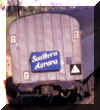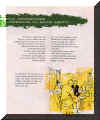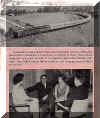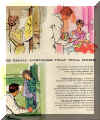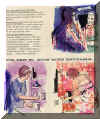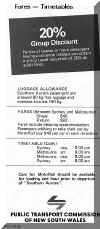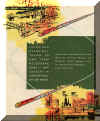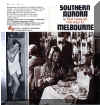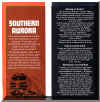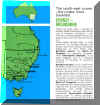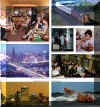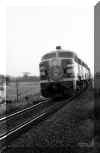|
The Southern Aurora was a true “ Limited Express”. It conveyed passengers only between the starting and terminating points ( although later in its life some limited intermediate traffic was allowed, this was at the full through fares). Uniquely in Australia, it conveyed only First Class passengers, all of whom were accommodated in air-conditioned sleeping cars, all of which were equipped with showers. The Southern Aurora was introduced when part of Australia’s gauge problem was solved with the construction of a new standard gauge line, 197 miles long from Albury ( NSW), parallel to the existing broad gauge line to Melbourne, connecting Australia’s two largest cities by standard gauge. Since the opening of this line in 1962, more conversions have taken place, and all main land State capitals are now connected by standard gauge, with a new line to Darwin ( Northern Territory) scheduled for completion in 2004.
|
| Three daily through trains operated
over the Sydney-Melbourne route: the Intercapital Daylight,
fastest at 12 hours 35 minutes for the 597 miles, the mostly sitting car
overnight Spirit of Progress, and the all-sleeper, all-new Southern
Aurora. The other trains used existing stock.
|
| The Southern Aurora consisted
of 14 stainless steel cars: a luggage van, a power van, a dining car, a
lounge car, and ten First Class Sleeping Cars. The carriages may appear
to bear a distinct resemblance to the Budd cars built for the California
Zephyr: and there is a reason for this ( see Carriages).
|
| The Sleeping Cars were of three types. The LAN
contained twenty single berth cabins known as Roomettes, each with a
folding toilet unit, with two shower compartments at the ends of the
car. The berth when raised formed an armchair, and there were a full
length mirror, a wardrobe, iced drinking water and reading and night
lights.
|
| The NAM contained ten two berth
compartments known as Twinettes, each with an en-suite shower and toilet
compartment. The lower berth formed a sofa to seat three.
|
| The DAM contained eight twinette
compartments: two pairs of these compartments connected through the
adjoining shower compartments, making them suitable for families. The
other four compartments were standard twinettes. In the centre was
a Deluxe compartment, with a fixed lower double bed, and a folding upper
berth. There were two armchairs in a sitting area, and a larger
ensuite bathroom. This compartment had two large windows, all
other compartments had one.
|
| The total capacity was thus 198, for a
train weight of 630 tons ( and the 14 carriage set was 1,075 feet
long).
The train was hauled by two main line diesels in NSW, and one in Victoria. Departure time from both capitals was 8 pm, and arrival time was 9 am. For a number of years, there were no intermediate stops for passengers, and the train had the longest non-stop run in Australia, 267 miles from Goulburn to Albury. Dining car crews changed at Goulburn and Albury, and locos were changed at Albury.
|
| The Southern Aurora name
was kept secret until it was announced with the inauguration of the
first train: the name appeared as Sydney or Melbourne Limited Express in
the first public timetable, and on one of the menus illustrated on the Dining
Car page. The first train ran from Sydney on Thursday 14 April 1962,
with full regular services starting from both Sydney and Melbourne
on Monday 16 April 1962.
|
| The introduction of a Motorail service
in 1973 ( passengers’ cars were conveyed on a car-carrying flat car
marshalled at the rear in NSW, leading in Victoria) meant that the
distinctive fluorescent light nameboard at the rear of the train was
removed, as it fouled the Motorail wagon.
|
| A steady decline in patronage( and a
lack of marketing) saw the end of the train in August 1986. The
two overnight trains were amalgamated into the Sydney Express and the
Melbourne Express. The Dining and Lounge Cars remained for
Sleeping and First Class Sitting passengers.
|
| Even this combined train was not to
last long, for it was replaced by a daylight and an overnight XPT
service. The XPT is a sitting car train, based on the British
diesel High Speed Train ( HST), and has one sleeping car, and no dining or lounge
car. XPT sets, and their close relatives, the XPL railcars,
now operate the few remaining NSW long-distance trains.
|
| The nation was shocked in 1969: on the
morning of 7 February the southbound Southern
Aurora collided with a northbound goods near Violet Town,
Victoria. Nine passengers and crew were killed, and seven
carriages were destroyed. A few more details appear on the Carriages
page.
|
| Perhaps the strangest story about the Aurora
was that the dining car girls operated a prostitution racket on
board. The Melbourne Truth published such an allegation in
the 1960s, but it was easily refuted as only male stewards and
conductors then staffed the train.
|
| Why was the Southern Aurora
considered to be " The Finest Train in the World"? Was
this just Public Relations exaggeration? The standard of accomodation
certainly matched that of the best American trains, and the facilities
such as full air conditioning and all ensuite toilets were superior to
those in Europe, even if the décor did not match that of the CIWL
Grand-Luxe cars. Meals were tasty and well-presented, and there was
pleasure to be found in the Lounge Car, which was an excellent place to
enjoy a cheese platter after dinner.
|
| The three hours of daylight running on the morning of arrival were also pleasant, with breakfast in the dining car taken as the train either descended the Southern Highlands in New South Wales, or climbed to cross the last vestige of the Great Dividing Range in Victoria. |
